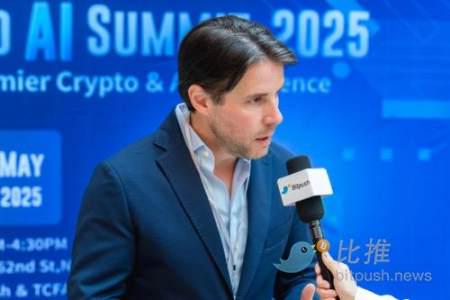Author: BitpushNews Mary Liu
At the CryptoAI Summit 2025 hosted by Bitpush, we had an exclusive interview with John D'Agostino, Director of Strategy at Coinbase Institutional. As an important participant in the process of crypto institutionalization, John shared his industry insights on the evolving role of Bitcoin, institutional crypto adoption, decentralized finance, and stablecoins.
Guest Profile
John D'Agostino is the Director of Strategy at Coinbase Institutional. He serves on the boards of several large hedge funds and venture capital funds, public companies, and the Alternative Investment Management Association (AIMA).
In 2019, John co-founded the AIMA Digital Assets Working Group. In 2021, he was appointed by the British Consulate in New York as the Chair of the Royal Asset Management Working Group. In 2022, John was appointed as a Financial Innovation Fellow of the AIF Global Pensions Network, and in 2024, John was appointed as a Research Fellow at the MIT Computer Science and Artificial Intelligence Laboratory (CSAIL).
As the former Director of Strategy at the New York Mercantile Exchange, John led the effort to establish the first Middle Eastern energy derivatives exchange in partnership with the Government of Dubai, which led to him being the subject of two New York Times bestsellers (Rigged and Start Up Of You).

“Bitcoin has decoupled from broader tech stocks”
The day before the summit, BTC returned to $100,000 after several months, sparking discussions among investors about the return of the "bull market".
When asked about his views on this market sentiment, John D'Agostino said: "BTC has reached $100,000 before, and these numbers are really very important psychologically. They can make the public pay more attention to such assets. I remember the first time crude oil broke through $100 per barrel. That was a big moment. However, we should not overemphasize a specific number. I think what is more important is that we see this price trend at the same time that Bitcoin has decoupled from broader technology stocks. To me, this is more interesting."
John told Bitpush: “If Bitcoin was only at $90,000 today instead of $100,000, but it had decoupled in this way in April and early May, I would still be happy as an investor - if I bought it to improve the Sharpe ratio and upside capture rate (which we call the Sortino ratio) of the portfolio. Both in terms of its economic relationship with other assets and in terms of absolute performance, Bitcoin is operating in the way people expect it to.”
Institutional whales: a decade-long “quiet accumulation”
Since the approval of the spot Bitcoin ETF, more and more institutional investors have begun to invest in Bitcoin. According to SoSoValue data, as of May 15, the total inflow of US spot Bitcoin ETFs reached US$343.47 million, continuing the inflow momentum for five consecutive weeks since mid-April.
John D'Agostino told Bitpush: "Even in periods when Bitcoin is down and people are not paying much attention to Bitcoin, we never stop seeing growth in institutional interest. When we talk about institutions, many people mean hedge funds and asset management companies. The responsibility of these entities is to find new ways to make money and new sources of alpha. They have a responsibility to pay attention to new asset classes that have the potential to generate alpha. So for a decade, their interest has been quietly growing and has never stopped. In essence, this growth has been slow and steady."
John explained: “They really like assets that are not highly correlated with other asset classes, they like volatility - it may scare off some retail investors, but institutions like this volatility. They like assets that provide protection when they fall, volatility that allows them to trade, and also profit when broad assets rise. So Bitcoin has all of these characteristics.”
“Now, because institutions tend to trade in larger volumes, more frequently, and have more reporting requirements than the average retail user… they need institutionalized markets, they need compliant markets. We already have that now. Coinbase has been operating in a compliant manner for a decade. But recently in the U.S., there has been a change in the way the government and regulators treat this asset class, which has given institutions more confidence to trade on compliant platforms without worrying about getting into any regulatory trouble in the U.S. That’s a relatively recent change. So I think naturally, we’re seeing more institutional interest, but that interest has never stopped.”
Governments and sovereign wealth funds are about to join the wave
BitPush previously reported that New Hampshire became the first state in the United States to pass the "Strategic Bitcoin Reserve" bill, and John also mentioned the growing involvement of government agencies. He said: "Many states, countries and sovereign wealth funds are already investing even if they have not announced it publicly."
He told Bitpush: “Honestly, I think the only thing that’s holding this back is leadership change. As new leaders are elected — people who are more open, more willing to understand the technology, more willing to learn about this innovation… As long as they take the time to listen to their constituents and understand the technology, it’s pretty clear where we’re headed. You’ll see more and more states, countries, and government-backed entities like sovereign wealth funds not only research it, buy it, but are willing to admit that they do hold these types of assets. It’s just a matter of time.”
DeFi and stablecoins are the perfect partners
John is very optimistic about the development of DeFi and stablecoins, and believes that the rapid expansion of DEFI cannot be separated from the support of stablecoins.
He said: "I think that centralized exchanges (CEX) and decentralized exchanges (DEX) will continue to increase in the future, but there is no doubt that now is a good time for decentralized finance (DeFi) and it is also an exciting time for stablecoins. The two complement each other. DeFi needs a stable and scalable transaction layer-and stablecoins happen to meet this demand perfectly. Stablecoins are like lubricants for DeFi applications, enabling rapid expansion of various applications from derivatives to cross-border payments."
John believes that stablecoin-based DeFi applications, especially in the field of cross-border payments and derivatives, will grow exponentially in the next 1-3 years. He told Bitpush: "While the prediction of 'trillions of dollars in stablecoin trading volume' may be a bit radical, there is no doubt that the size of this market will be much larger than it is now."
"Regardless of short-term prices, Bitcoin still has a significant effect on portfolio optimization"
When asked about his views on the future trend of Bitcoin, John said that the core function of the exchange is not to predict the market, but to provide a reliable price discovery mechanism. He mentioned that the psychological impact of integer thresholds (such as $90,000 or $100,000) does exist, but what is more worthy of attention is the change in the correlation between Bitcoin and traditional assets (especially technology stocks). "If Bitcoin can maintain a low correlation, even if the price temporarily stops at a certain point, its optimization effect on the portfolio will still be significant."
John's sharing made investors more convinced: the crypto market is shifting from retail-dominated to institutionalized. As the compliance framework becomes more and more perfect, as sovereign funds quietly make their plans, and as DeFi infrastructure continues to evolve, we may be standing at the critical point of a new round of qualitative changes in the industry.





